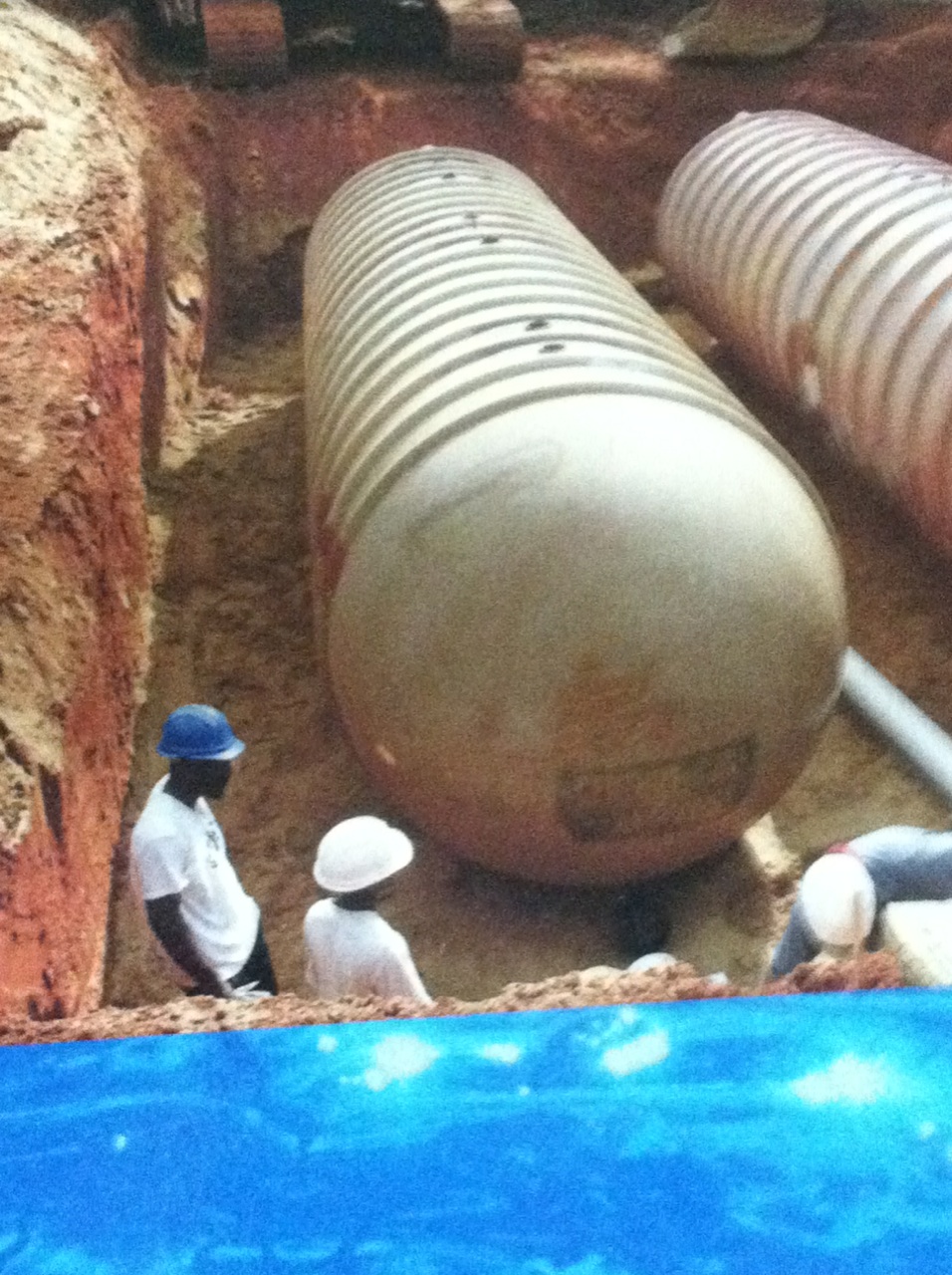
by Heidi Copeland | Apr 25, 2014

Leon County Extension’s sustainable rainwater cisterns collect rainwater from the rooftop and use the water from the cisterns to irrigate the demonstration garden.
According to the Environmental Protection Agency (EPA), the term “sustainability” has emerged as a result of significant concerns about the unintended social, environmental, and economic consequences of rapid growth. Sustainability is based on a simple principle: Everything we need for our survival and well-being depends, either directly or indirectly, on our natural environment. Therefore, sustainability creates and maintains the conditions under which humans and nature can exist in harmony, fulfilling the social, economic, and other requirements of present and future generations.
WHEW! Think about it! Sustainability is important to making sure that we have, and will continue to have, the water, materials, and resources to protect our health and our environment.
Think about it! Water, for instance. Though we might see water as an abundant resource in Florida, water is emerging as a sustainability issue sparking debate and illustrating the differences in opinions of various water users in Florida. Consider these facts:
- Heavy demand: High levels of commercial, real estate, and agricultural development have caused withdrawals to increase over time, putting pressure on natural resources.
- Changes in water use: Agricultural production and public supply are the largest users of freshwater resources in Florida. Large demands occur in municipal water supply systems as a result of landscape irrigation of lawns and golf courses.
- Environmental consequences: Depletion of groundwater resources can have negative environmental consequences, such as saltwater intrusion into freshwater resources and sinkhole development.
- Water use strategies: Strategies to balance water use include reducing the overall demand for water (through such means as increased water prices or restrictions) or increasing the supply of water (through such means as desalination of seawater).
- Water quality: Recent EPA nutrient requirements designed to protect water quality.
Just think about it! Just like there are many levels of sustainability, each and every one of us can draw from advances in science and technology to protect not only our health but the environment.
Just think about it! And then take action. The EPA website has data specific to your area of interest. Information on air, water, land, community, health, and energy can be visualized on a map, downloaded, and printed.
Think about it! Individuals can make a difference! A journey of a thousand miles begins with a single step. Each of us can promote practices to strengthen our natural environment and quality of life, ultimately improving the quality of life for everyone.
Sources: http://www.epa.gov/
UF/IFAS FCS 7242 Understanding Sustainability: The Importance of Sustainable Development and Comprehensive Plans—Goals, Objectives, Policies
UF/IFAS WC151 Water Issues in Florida: How Extension Can Facilitate Stakeholder Engagement and Involvement
by Shelley Swenson | Apr 7, 2014

April 26, 2014
9 a.m. to 2 p.m.
Crawfordville, Florida
TCC Wakulla Center and Hudson Park
Come one, come all to the Green Living Expo offered to all citizens of the Big Bend area. I love the adopted tagline… Experience a simpler, more sustainable life. Learn ways to save money and reduce your impact on the Earth.
Those of you who have attended a previous Expo will remember this event is a gathering of all kinds of people who are like-minded in that resource management is a life goal. The event is offered to allow people to share ideas on how to incorporate these sustainable practices into their lives.
The Green Living Expo provides an opportunity for the entire family to attend and spend time as a family in addition to pursuing independent activities based on age and interest.
Activities to be offered:
- Sustainability Workshops
- Bicycle Events
- Green Flea Market
- Green Exhibitors and Products
- Children’s Activities
- Food
- Raffles
Go to www.sustainablebigbend.org or call Wakulla County Extension at 850-926-3931 for more information.
by Shelley Swenson | May 20, 2013

Salt water continues to make it into our fresh water supply. Will you conserve?
I had the privilege of spending a day recently with children from Medart Elementary School for their annual Project Learning Tree (PLT). During PLT, community representatives make presentations on nature, conservation and sustainability practices. The 2013 theme was Wakulla Life is Nice!
I decided to speak on water conservation since we live in such a wonderful part of Florida with an abundant amount of clean, fresh water. Through an imaginary trip to Wakulla Springs, the children and I noted the clear water and discussed how and why it remains that way. We concluded that we were quite special to have the Springs so close by to enjoy. I reminded them that people visit Wakulla Springs from all over the world to witness the clear, clean water and that water is not that way for many people around the world. I used a poem written by a student who wrote,
“When I look through my water window….
I see lake water for fun.
I see ocean water for surfing.
We’ve got water by the ton!
But when I look a little closer for the part that we can use,
I see we’ve only got a little;
if I waste it – we ALL lose!”
The students were reminded that even if a world map looks like it contains a lot of water or 71% of its surface, 96% is salt water and the other 4% is fresh. When looking at it through this lens, the amount of water on the earth’s surface looks somewhat different. We decided that there was “water, water everywhere, but only a few drops to drink.”
I suggested ways that they might assist to save the 4% of fresh water on the earth’s surface. The United State Environmental Protection Agency offered some great facts to allow the children to get a better grip on how people use or misuse water. For example, did you know that:
- A household can save up to 20,000 gallons of water each year by fixing leaky faucets. A leaky faucet puts 3-5 gallons of water down the drain every minute.
- More than five gallons of water is wasted if the tap water is running while brushing teeth. Only ½ gallon of water is used if the toothbrush is just wetted and rinsed. This results in a 4 ½ gallons savings each time teeth are brushed.
- Washing dishes with the tap running can use an average of 30 gallons of water.
- Washing a car at home, using a hose, uses up to 150 gallons of water. Washing a car at a self-service car wash uses 5-10 gallons. Using a sponge and a bucket, uses 1.5 gallons.
- Taking a bath uses between 30-50 gallons of water. A 4 minute shower takes 20 gallons. If your shower is longer, it could use more water than a bath so the secret is with either a bath or shower, to get in, wash and turn the water off. A low-flow showerhead will also assist in the saving of water.
I then asked the children to sign a pledge. It read: “PLEDGE TO SAVE WATER. I know that our Earth’s water supply is limited. I will do my part. I will turn off the water while brushing my teeth and I will shorten my shower to 4 minutes.” 99% of the Medart Elementary students who participated signed the pledge. I was proud of them and the decision that they made.
Are you willing to conserve water to keep the world from losing the fresh water available??
by Heidi Copeland | Apr 17, 2013

Two-thirds of American household waste is due to food spoilage
Sustainability – 1. The ability to be sustained, supported, upheld, or confirmed. 2. Environmental Science: The quality of not being harmful to the environment or depleting it.
This Earth Day, think about the dictionary definitions of sustainability, especially as they relate to consumer choices. Take food, for instance. As a nation, not only are we becoming super-sized but so is our food-related waste. In August 2012, the Natural Resources Defense Council (NRDC) reported that Americans are throwing away 40 percent of their food supply in the U.S. every year. The reasons for this problem are multifaceted. Nevertheless, consumers are a major contributor to the problem. Key findings include:
- The average American family of four ends up throwing away an equivalent of up to $2,275 annually in food (I’ve started to tally up my own family waste and believe me, it adds up! Leftovers not eaten in time, half a can of evaporated milk, brown lettuce, wilted carrots, yellowing broccoli, etc…)
- In average American households, two-thirds of household waste is due to food spoilage
- 40 percent of fresh fish
- 23 percent of eggs
- 20 percent of milk
- Citrus fruits and cherries top the list for fruits, and sweet potatoes, onions, and greens are commonly wasted vegetables
- Much of household waste is due to over purchasing, food spoilage, and plate waste.
- One-third is caused by people cooking or serving too much (Package size, serving size, and dishware size all influence how much each of us eats).
Wasted food also translates into wasted natural resources because of the energy, water, and farmland necessary to grow, transport, and store food. Additionally, food waste is the single largest component of solid waste in U.S. landfills.
Every one of us can be a facet in solving this increasing problem. Each person can waste less food by:
- shopping wisely
- knowing when/how food goes bad
- eating produce that is perfectly edible even if it’s less cosmetically attractive (much of this is thrown out)
- cooking only the amount of food you can reasonably eat
- eating leftovers (consider them a bonus for lunch tomorrow)
Norman Vincent Peale says, Change your thoughts and you change your world. Can the same thinking apply to our behavior? If each and every one of us made a small behavior change, it could help change the world.
For more information: http://www.nrdc.org/food/wasted-food.asp
http://www.nrdc.org/living/eatingwell/saving-leftovers-saves-money-resources.asp





